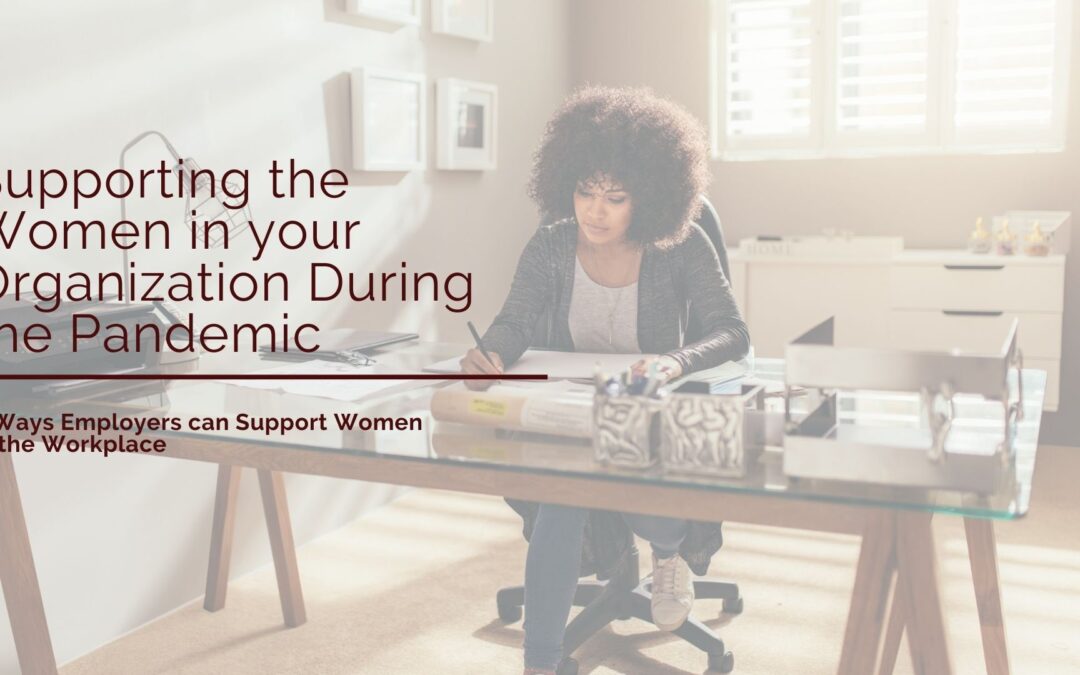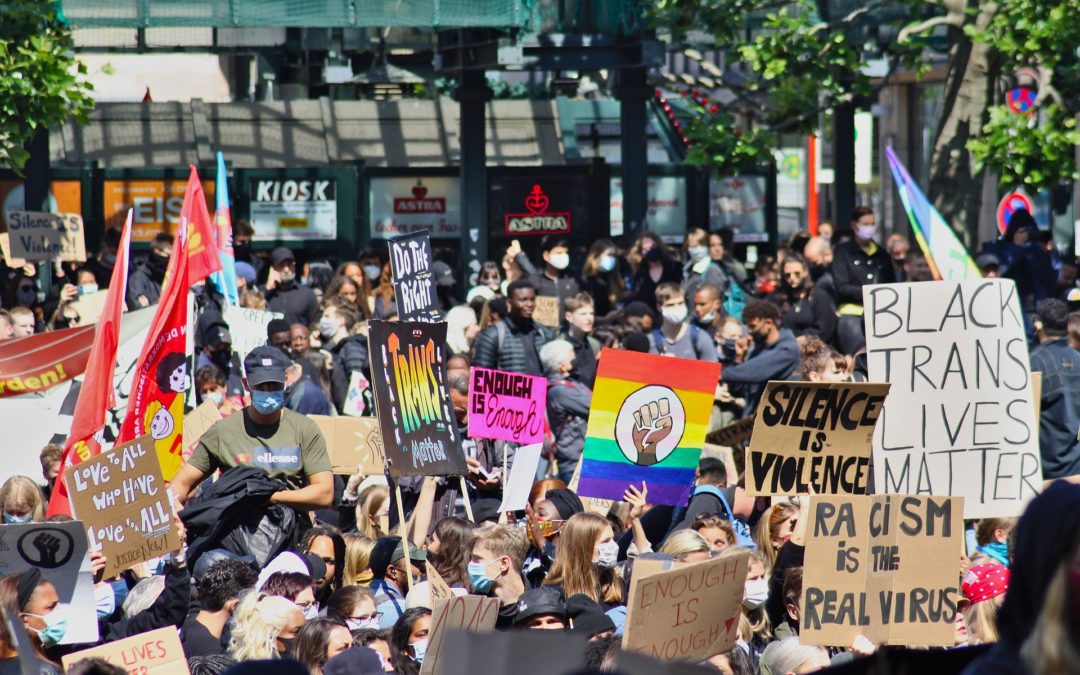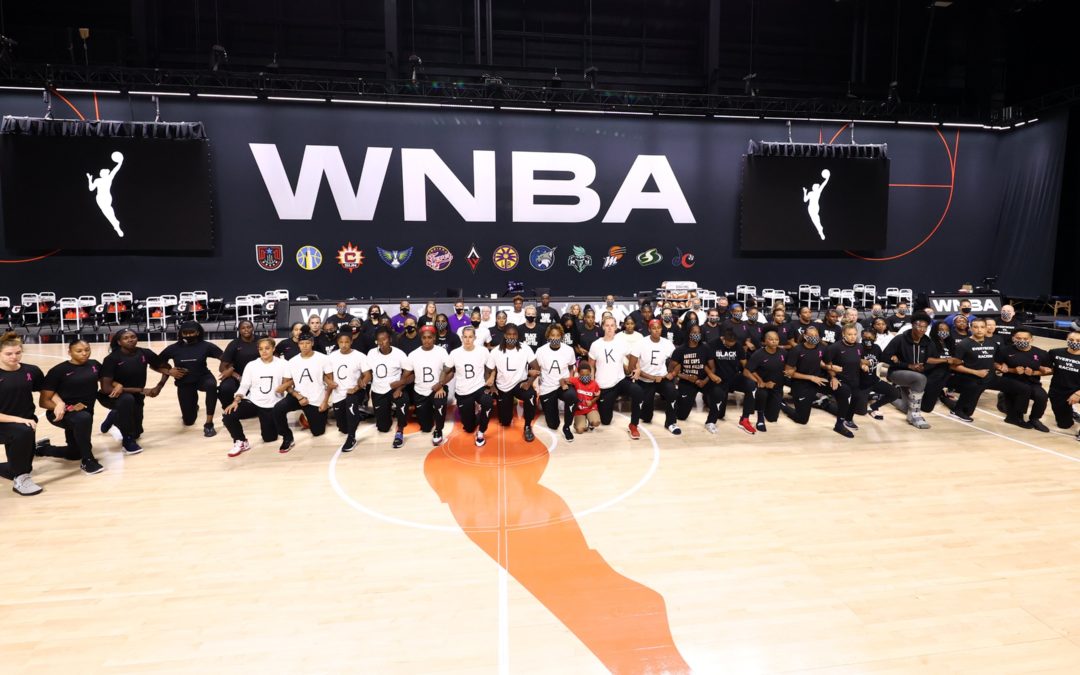
by Staff | Nov 26, 2020 | Business, Community, Diversity, Equality, Leadership, Management
To say that this year has been tough for everyone is an understatement. The Covid-19 pandemic has touched every single person in the world and has unapologetically changed everyone’s lives for the foreseeable future. From wearing masks at the grocery store, waving to your friends and family from a two metre distance, and saying “sorry, my wifi cut out” in zoom calls, are all aspects of everyday life that have changed. However, specific groups have been more affected than others. Women and specifically women of colour have been particularly affected by the pandemic. Senior level women are 38 percent more likely to mentor one or more women of colour compared to 23 percent of men. If we let women leave the workforce, this could have detrimental effects on an organization’s profits and overall work culture that we simply can’t afford.
The challenges women face in the workplace have only intensified in the last six months. Many of these women are working mothers and are now working a “double shift” while balancing their careers, children and keeping up with their homes. As a result of this work/life imbalance, one in four women are contemplating leaving the workforce and leaving behind years of hard work. However, this is extremely alarming for corporate America.
Companies risk losing their women in leadership positions and unwinding all of the progress to implement gender diversity in the workplace. However, this presents itself as an opportunity for organizations. This is the time organizations need to invest in their talent to ensure women have the resources and flexibility during these times to ensure that they don’t leave the workplace. Employers need to foster a sense of nurture culture where women have an equal opportunity to fulfill their potential and career goals.
Losing women in the workforce would translate into a significant financial loss to companies. According to the research, company profits and share performance can be almost 50 percent higher when women are well represented at the top. Alongside the profit, women also carry a lot of importance when it comes to creating a positive work culture, employee-friendly policies, and champion racial and gender diversity.
6 Ways Employers can Support Women in the Workplace
- Make work more sustainable
Adapting the everyday work-life is essential when supporting women in the workplace. Employers might want to look at the productivity expectations before Covid-19 and adapt them to be more realistic. This might encompass resetting goals, narrowing project scopes or extending deadlines. Another way organizations can support employees is by offering “Covid-19 Days” to give parents a chance to catch-up with their home life or a day to simply recharge.
2. Reset norms around flexibility
The pandemic has made it harder to strike a good work-life balance as employees might always feel like they are “on”. One way to help improve the balance is to establish set hours for meetings and responding to emails. Leaders can also communicate their support for workplace flexibility to help mitigate the feeling of “always being on” and that it is encouraged to take advantage of flexible work options. When employees believe their employers are supportive of their flexible practices, they are less likely to consider downshifting their careers or leaving.
3. Take a close look at performance reviews
Performance reviews are a great tool to help gauge how your employees are doing and rewarding their contributions. However, with the shift to remote work, new challenges have risen and the old criteria before Covid-19 may no longer be applicable to today’s environment. Employers can relieve stress by making the performance criteria more attainable to help prevent anxiety and burnout. Ultimately, this can help with overall performance and productivity.
4. Take steps to minimize gender bias
Throughout this pandemic, biases against women have been amplified and have shown up in new ways. Either kids playing in the background of zoom calls or co-workers assuming their colleagues are doing less work due to taking care of their children while working from home. Since there is less visibility into the day-to-day there leaves room for bias to creep in.
In order to mitigate the biases women face, managers need to ensure that their employees are aware of them. Employers should speak publicly about the impacts of biases, especially during the pandemic. Bias training and tracking promotions between genders is a good way to track if men and women are being treated fairly.
5. Adjust policies and programs to better support employees
Due to the pandemic and its changes to “normal life”, organizations have extended policies and benefits to help support their employees. Resources for mental health and homeschooling are examples of what organizations have in place to help with the new adjustments. As an employer, ensure that all your employees are made aware of the resources that are available to help them during these challenging times. Organizations should also determine if their resources and benefits are addressing the employee’s needs and reallocate time and money for the challenges your employees might need support in.
6. Strengthen employee communication
When shifting to remote work, communication with your employees is critical to ensure that they still feel connected with their managers and peers. One in five employees have consistently felt uninformed or in the dark during the Covid-19 pandemic. Leaders and HR teams should have regular communication and be empathetic towards their employees to make sure all team members feel valued and understood. It has been shown that this practice can reduce anxiety and build trust among teams.
Ensuring that women in the workforce don’t fall through the cracks is essential during the Covid-19 pandemic. All practices have to adapt to these unprecedented times to allow for more flexibility and understanding in the workplace. We have to ensure that we strive for gender equality in the workplace and that we have women paving the way for the younger generations. We have to look at each other as human beings and not just robots that work from 9 to 5. This pandemic is something that no one has ever experienced before and we are all learning how to maneuver through it the best way we can. Organizations need to adopt more flexible and accommodating practices to make sure all their employees can thrive in this new environment.

by Staff | Oct 15, 2020 | Diversity, Equality
No Burning Buildings for Her
Our neighbours to the south have taken center stage in global media yet again. With dramatic imagery of riots and burning building over the racially motivated crime and police brutality filling our news feeds and headlines, there is a need for pause and need for Canadian reflection. Are we as innocent as we would all like to think?
Since the murder of George Floyd in May of 2020, racial violence has been at the forefront of everyone’s minds. Canadians, and subsequent media outlets, have taken a unique stance on the violence south of the border. Thirty-seven million of us have sat on our high horses and looked down at our closest ally and trading partner, acting as if we have nothing to hide and could not possibly be as blatantly racist and violent as them. We could not be more wrong. The media has painted the United States as a chaotic and foreign place in the Canadian press, capturing every minute of the riots and exclusively covering US-based human rights violations. The states are so crazy; how could they possibly not have this under control? How can their people stand for this?
We couldn’t possibly allow such heinous crimes here, right?
Think again.
We have collectively turned a blind eye to the national human rights crisis right in our backyard. That is right. A national human rights crisis in Canada that is drawing international attention from other United Nations members. Our indigenous women and girls are being attacked at an alarming rate, and no one seems to care. That is unless you are one of the multiple organizations and governing bodies that seem to be sweeping this under the rug. This is not a small problem, nor a new one. Statistics Canada conducted a study in 2009 and found that Indigenous women were three times more likely to report violent crimes from either strangers or domestic violence. That is if they can report it; that same study also found that Indigenous women are seven times more likely to be a victim of homicide than other racial profiles. This systemic racism is also prevalent in, you guessed it, our police force. Even though Indigenous women make up only 6% of Saskatchewan’s population, they account for up to 60% of the missing person’s cases.
These staggering statistics have two possible explanations. The first being that these crimes are racially motivated and are carried out as hate crimes against the Indigenous population. The second, and much more chilling, is the realization that these women are specifically targeted as victims of violent crimes because the perpetrator believes that they can evade prosecution for their crimes as it is highly likely that the victim will be discriminated against in the judicial system. Perpetrators are selecting Indigenous women as victims because society has proven that we do not seek justice for these women with the same conviction as we do victims of other races. And do not think that Justin Trudeau has this crisis under-wraps. Humanity organizations have brought the issue to the United Nations Council. Twenty-four separate countries voiced concern for Canada’s indigenous women. Few of which, including New Zealand and Switzerland, have called for a decisive plan to be made to protect these Canadian women. Canada did not acknowledge the need for change.
Further, three different international human rights organizations have made trips to Canada to at least in part investigate the crisis. Yet we, as a country, continue to show that we are indifferent to the crisis. Our national hubris prefers to demonize the United States for their appalling lack of government intervention about the racial human rights crisis. At least their people recognize the problem. This national human right crisis has hypocritically been skipped by many of the major news outlets as they cover the soap opera in the United States. We have ignored this messy crisis, resisting accepting that everyone has a part to play in this problem.
This hypocrisy can be seen in the workplace. Our workplace culture must change if we are to save our Indigenous women. We must become more accepting and demonstrate our commitment at a corporate level in our hiring, diversity strategies, and our corporate social conscience to investigate any potential connections to the violence. Organizations must ensure that they are not unknowingly supporting this crisis financially. We must advocate as companies and people to change our culture in and out of the office and prioritize these women’s safety. It is the corporation’s responsibility to educate themselves on the battle’s Indigenous women face in the workplace.
Leveraging a more inclusive recruitment process can be the first step in creating a more accepting environment for these women. Things like adding a wage range, creating a buddy system or reviewing company policies are steps in the right direction to ensure we are being inclusive to everyone, especially Indigenous women. Having the opportunity to thrive in the workplace would give these women the chance to escape poverty and violence in their communities.
Our Indigenous women need the support and protection of their nation. Canadians need to do better. Our systemic racism has landed many Indigenous women in inescapable poverty and precarious situations that put them at high risk for violence. We need to give these women the ability to escape these dangerous situations through education and work opportunities. Support from companies and people alike to make Canada the inclusive place we claim to be could not be more needed right now for the women who started our nation
A significant factor in the crisis is the failures of outdated police procedures that do not consider the alarming and disproportionate rate at which our Indigenous women are going missing. We need to ensure that crimes are being investigated with the same tenacity concern as any seemingly connected violent crimes. These are not random attacks. Our judicial system is failing our Indigenous women through deep-rooted racism and marginalization. These attacks are happening at such an alarming rate that we can not stop at jurisdiction lines. This is a problem across the nation, and our law enforcement procedures fail to consider this.
Canada has an immediate need for a coordinated nationwide effort and action plan to stop this human rights crisis in our own homes. We need it, and we need it now. We can not continue to look at the United States as if we have any moral high ground. We are allowing the slaughter of an entire peoples right under our noses yet shaming the United States and holding rallies with thousands of people for a single man thousands of kilometres away. But we turn our backs when our people need us? We need to show that this is the news we care about and the policies we all need to care about before it is too late.
It is already too late for hundreds of Indigenous women and their families.

by Manpreet Dhillon | Aug 27, 2020 | Diversity, Equality
It was a historic day, August 26th, 2020. It is days like this that the energetic shift in the world is felt. Where the butterfly effect becomes apparent where we know that one action can have a ripple effect in other parts of the country and the world. It was the day that we saw individuals that millions look up to take a stand to create change in the world. It was the day we saw games in the NBA, WNBA, MLS and MLB canceled as the players felt more needed to be done in the #blacklivesmatter revolution.
This day showed us that a decision, an action, taking a stand can matter. It doesn’t matter the size of your platform, you can still create change. You do have a responsibility if you do have a platform to create change.
Over the last few months, I have heard clients tell me that their employees said that the black lives matter movement had no place in their business while others called out their leaders and team members for not doing enough.
This is time to know we all have a part to play in doing something. We all have a part to take action as it is a human issue, not a political issue. Humans are being killed because they are being profiled, they are being judged for their exterior, someone is forgetting that the blood that runs through the veins of the victim is the same color as the blood that runs through the veins of the murderer.
I grew up with the uttermost respect for authority as that is what I was taught. People with authority included those in uniform or positions of power. Time and time again, we hear where people are abusing their power. It is not each of them. There are many of them who are keeping the communities safe. Many of them are doing the best that they can. The issue is the ones who have a hatred for another group of people, those are the ones I am talking about. That hatred is then passed along to their children, their neighbors and their friends. Hatred spreads the same as love. It can be a poison that is fed on fear of the unknown, the fear of someone being different, the fear of feeling out of control.
This same hatred and fear shows up in our workplaces, in the bias that are held, the unequal power structures and systemic oppression. The solution to this fear and hatred is multi-faceted. It is education. It is the awareness. It is acknowledging and calling out when something or someone is violating the human rights of another. It is creating systemic change in how we challenge the economic structures that further create inequality. It is bringing justice in the name of those who can not fight for themselves. It is showing up each day to do better and be better.
What I am saying has all been said before. I know. I just hope that through reading this one person will realize that there is room for improvement in their own lives. That they can educate themselves on how they may be perpetuating racism or where their bias is when it comes to who they interact with, hire, and promote. That they realize they have a voice that they can use to speak up for those who can not speak up for themselves. That they realize that they can give an opportunity that does not exist for someone else as they would never have access to it. These changes are what will bring justice, and make August 26th a day where the ripple effect was felt for generations in the future.

by Manpreet Dhillon | Sep 5, 2019 | Community, Diversity, Equality, Leadership
At Veza, we honour the work of inspiring leaders every single day. Not just the known and notable but rather, everyday women who are drawing upon and celebrating their culture while making a lasting difference in their community using their gifts. From authors and teachers, CEOs to entrepreneurs, not-for-profit directors, artists, and more, these women are changing the face of leadership.
These are truly women to watch and Veza Community is so pleased to share their brilliance.
May their stories inspire YOU to rise.
Meet Hurriya Burney
Hurriya Burney is Vice President, Commercial Banking, at RBC Royal Bank. She leads a team of 13 Commercial Accounts and leads RBC’s Healthcare segment strategy in BC. Hurriya holds an MBA in Finance from the University of British Columbia and a Bachelors in Economics & Business and English from Lafayette College.
Find her on Instagram
If you know a leader we should feature please invite her to share her story with us here.

by Manpreet Dhillon | Jul 18, 2019 | Diversity, Equality
Canada is my home. I was born here. Tips to overcome the challenging of one’s identity.
This week, we have seen the statement “go back to where you came from” all over the news. In Trump’s latest controversy, he suggested four progressive congresswomen go back to their own countries. All are American citizens and three of them were born in the US. The incident has brought up a lot of emotion in many of us watching across the world. These types of comments can leave us feeling angered, enraged, hurt, confused, and unsafe.
Many persons of diverse backgrounds born and raised in Canada and the US have had this statement directed at us, especially when we were younger, and many of our parents heard it in the workplace. “Go back to where you came from” style statements usually arise in a conflict or in some form of retaliation, especially where the culturally diverse person has the perceived upper hand. It’s a low blow that is challenging to respond to.
The first time I heard this comment I was in grade 6 and it was made by a “friend” with a Japanese background who was mad at me. I just looked at her and said, “But we are both born here, so where would we go?” I remember my teacher talking to me about it and having us both apologize. She admitted she said it because there was nothing else she could say to hurt me. I forgave her, but I wasn’t sure of how this comment would impact me.
I am not the only one who has gone through this and I share my story because I know many others can relate. The “You don’t belong here” discrimination has been leveraged against my parents, my friends, their parents, our cousins… the list goes on.
It is so difficult to hear this comment in particular as it does challenge one’s sense of self and one’s identity. It challenges where people feel at home and where they feel like they belong. It challenges how safe they feel being in the country they live in.
It was really difficult to go back to school for a few days. I wasn’t sure of my place, as I didn’t know if my other classmates felt that this country wasn’t home for me either.
When you experience a shaken sense of self around your belonging, it may impact your work, cause extra stress and unknowingly impact how you show up in the world. Some people hide, while others get angry and there is an entire spectrum of valid responses in between.
Here are 5 strategies that you can use to move through this experience:
- Find a way to express the emotion in a positive manner. The emotion is not only in response to what is happening now but is arising in the context of what has been happening for generations. It may be about the injustice of people being bullied and being treated like they are second class citizens. Outrage is valid, but that emotion needs to move and be processed – holding it in your body will cause deeper problems. So let it cycle. Journal, go to kickboxing class, talk it out with people you care about, punch a pillow, go for a run. Do whatever you need to do to come back to a strong sense of self and take back some control.
- Talk about what others, especially kids, are feeling. If we are going to end the cycle of people of culturally diverse backgrounds having to struggle and fight for their place, we need to focus on the kids and help them navigate their emotions and what is happening. Children hear snippets in the news or at school, so try to address the messaging they are receiving. Ask them how they felt and reinforce that they do belong. Also discuss what feelings are arising for your friends and family and ask how it is impacting them.
- If it is impacting your work, talk to your manager or HR representative and let them know that you need extra support. Such action is particularly important if there is something that needs to change in your organizational culture. Then you can take this as an opportunity to address and only discuss that issue, which should help resolve that feeling of ostracization and othering in your workplace.
- Remember that you do belong. Meditate on all the ways that this is your home and how you can feel more at home exactly where you are.
- Have compassion and forgive. Have compassion for those who make these comments, as bullies are usually broken and forgive yourself if you need to for your reaction to the situation.
It is up to you to take back the power and take back your place in the country. When people make hateful comments, address it, but recognize that they may not change from you fighting them. So show them in your own way that you belong in your home here in North America.

by Staff | Jul 5, 2019 | Business, Culture, Diversity, Equality, Leadership, Management
Millennials are stereotyped as being less competitive, entitled, avocado toast loving, technology addicted workers. Sure, many millennials are glued to their smartphones and social media, but that doesn’t mean they don’t have important things to contribute to your organization – nor does it mean that they don’t work hard.
By 2020, millennials will make up 50% of the workforce and their share of the workforce will continue to grow from there. On the whole, this group is goal and value driven and cares about its impact on society and the planet. So, millennials are not only going to represent a large portion of your talent pool but will also be looking to the job market for an opportunity to make that impact. That is good news for employers – hiring millennials can actually offer a number of (maybe) unexpected benefits to companies.
Perspective
There’s no denying it – millennials aren’t as experienced as the baby boomers in the marketplace, but boomers can’t beat the open-minded perspective millennials have. Millennials have experienced the world changing around them quicker than generation X, so they see new possibilities before they arise. They are always willing to think out of the box and come up with fresh and innovative ideas.
Plus hiring young employees can work out great if your business aims to attract young customers. After all, who knows better what the young generation wants than themselves? They’ll bring marketing and product design strategies that better appeal to their age group, which will kickstart your sales.
Qualified
Millennials are on track to be the most educated generation ever with 27% of women and 21% of men having completed a Bachelor’s Degree by age 33. Most of them are highly qualified, having done sometimes multiple internships to gain professional work experience. Hiring millennials will modernize your organization’s workforce, as well as bring the most up to date knowledge pertaining to your sector.
Tech Savvy
Millennials have grown up using computers, portable devices, the Internet, and social media. They have digital and technical knowledge at their fingertips. They pick up and apply technology better and quicker than the experienced baby boomers in tech-companies. You’ll have little or no trouble training these people on computer systems or new equipment.
Further, millennials are familiar with the latest communications technology and know their way around social media. There is no company in existence today that does not need a social media presence to be relevant. Even the millennials without a communications background can help you harness the power of Facebook, Twitter, and other social media platforms and turn that into brand awareness and sales.
Less focused on money
The older and more experienced generation have high expectations from their previous workplaces when it comes to compensation. The bottom line is usually their only bottom line.
Unlike baby boomers, the calculation millennials make is usually based on meaning rather than pay. A recent study of Canadian millennials showed that nearly half of this demographic would forgo a raise of about $9,000 to do work they considered more meaningful and impactful, so this benefit may not work for every job you offer. Also, with less experience, their salary expectations tend to be lower. But do ensure your salaries are competitive and commensurate with experience and responsibility. If you are truly unable to offer competitive salaries, millennials are more likely than other generations to be open to flexibility perks, such as remote days or additional vacation days.
Motivated
What’s better than having a highly motivated and excited workforce? Millennials are driven and deeply invested in what they do. They are motivated by their will to perform better and bring high-end results. It goes without saying how this particular attribute impacts your business outcomes.
They tend to be more tenacious and eager to learn in the workplace than other generations. Such a disposition leads to quick problem solving and adaptability, as well as a desire to get the job done well before moving on.
Collaborative
A survey of millennials conducted by IdeaPaint found that 74% of millennials prefer to collaborate in small groups, as opposed to large teams or on their own, and that 38% of millennials feel that antiquated collaboration processes actually damage their company’s innovation potential. Teams with more millennials mean better teamwork, less internal competition and more innovation. This leads to a stronger bottom line, but also a more positive work environment.
The Bottom Line is….
Hiring millennials helps you bring new and innovative talent into your organization. They are highly motivated and enthusiastic about their work. They know (or can find) their way around technology and are keen to learn new things, as well as seize new opportunities. The fact that they seek meaning through their work means that organizations have an opportunity to harness their enthusiasm towards achieving something greater.








 Ishu Kler is a photographer and Social Media Manager at Veza Global. She currently owns and operates a freelance photography company called Ishu Kler Creative where she specializes in branding, portrait and event photography. Born and raised in Vancouver, B.C., her love and passion for photography led Ishu to travel and live in New Delhi, India, where she obtained her Diploma in Photography. She also travelled to Costa Rica in 2015, where she obtained her Certificate in Documentary Photography from Photographers Without Borders.
Ishu Kler is a photographer and Social Media Manager at Veza Global. She currently owns and operates a freelance photography company called Ishu Kler Creative where she specializes in branding, portrait and event photography. Born and raised in Vancouver, B.C., her love and passion for photography led Ishu to travel and live in New Delhi, India, where she obtained her Diploma in Photography. She also travelled to Costa Rica in 2015, where she obtained her Certificate in Documentary Photography from Photographers Without Borders.
 Kelsey is a passionate Multimedia Designer & Communications Specialist with a diploma in Multimedia Production and over nine years of diverse design experience in different areas of the world including roles within multinational in-house marketing teams Microsoft and Technetix, marketing agencies and freelance. These experiences have led her to develop strong use of design principles, skills in Adobe Creative Cloud, knowledge in motion graphics and video editing, and knowledge in creating effective communication for a wide range of audiences and cultures.
Kelsey is a passionate Multimedia Designer & Communications Specialist with a diploma in Multimedia Production and over nine years of diverse design experience in different areas of the world including roles within multinational in-house marketing teams Microsoft and Technetix, marketing agencies and freelance. These experiences have led her to develop strong use of design principles, skills in Adobe Creative Cloud, knowledge in motion graphics and video editing, and knowledge in creating effective communication for a wide range of audiences and cultures.




